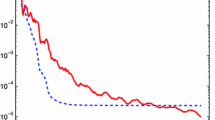Abstract
In this work, we prove the quadratic convergence of the Levenberg–Marquardt method for the inverse problem of identifying a Robin coefficient for the Stokes system, where we suppose that this parameter is piecewise constant on some non-accessible part of the boundary and under the assumption that on this part, the velocity of a given reference solution stays far from zero.






Similar content being viewed by others
References
Baffico L, Grandmont C, Maury B (2010) Multiscale modeling of the respiratory tract. Math Models Methods Appl Sci 20(1):59–93
Ben Abda A, Khayat F (2016) Reconstruction of missing boundary conditions from partially overspecified data: the Stokes system. ARIMA J 23:79–100
Bertsekas DP (1995) Nonlinear programming. Athena Scientific, Belmont
Boulakia M, Egloffe AC, Grandmont C (2013) Stability estimates for a Robin coefficient in the two-dimensional Stokes system. Math Control Relat Field 3:21–49
Boulakia M, Egloffe AC, Grandmont C (2013) Stability estimates for the unique continuation property of the Stokes system and for an inverse boundary coefficient problem. Inverse Probl 29:115001
Burger M, Osher S (2005) A survey on level set methods for inverse problems and optimal design. Eur J Appl Math 16:263–301
Chaabane S, Elhechmi C, Jaoua M (2004) A stable recovery method for the Robin inverse problem. Math Comput Simul 66:367–383
Chaabane S, Ferchichi J, Kunisch K (2004) Differentiability properties of the L1-tracking functional and application to the Robin inverse problem. Inverse Probl 20:1083–1097
Chaabane S, Feki I, Mars N (2012) Numerical reconstruction of a piecewise constant Robin parameter in the two- or three-dimensional case. Inverse Probl. https://doi.org/10.1088/0266-5611/28/6/065016
Daijun J, Talaat TA (2017) Simultaneous identification of Robin coefficient and heat flux in an elliptic system. Int J Comput Math 94(1):185–196
Daubechies I, Defrise M, DeMol C (2004) An iterative thresholding algorithm for linear inverse problems. Commun Pure Appl Math 57(1):1413–1457
Duvaut G, Lions JL (1976) Inequalities in mechanics and physics. Springer, Berlin
Egger H (2007) Fast fully iterative Newton-type methods for inverse problems. J Inverse Ill Posed Probl 15:257–275
Egloffe AC (2012) Etude de quelques problèmes inverses pour le système de Stokes. Application aux poumons. PhD thesis, Paris VI
Egloffe AC (2013a) Lipschitz stability estimate in the inverse Robin problem for the Stokes system. CRAS Ser. I 351:527–531
Egloffe AC (2013b) Lipschitz stability estimate in the inverse Robin problem for the Stokes system. INRIA Res Rep RR 8222
Engl HW, Hanke M, Neubauer A (1996) Regularization of inverse problems. Kluwer, Dordrecht
Facchinei F, Kanzow C (1997) A nonsmooth inexact Newton method for the solution of large-scale nonlinear complementarity problems. Math Program 76:493–512
Fan JY, Yuan YX (2005) On the quadratic convergence of the Levenberg–Marquardt method without nonsingularity assumption. Computing 74:23–39
Fang W, Lu M (2004) A fast collocation method for an inverse boundary value problem. Int J Numer Methods Eng 59:1563–1585
Fasino D, Inglese G (1999) An inverse Robin problem for Laplace’s equation: theoretical results and numerical methods. Inverse Probl 15:41–48
Fernandez MA, Gerbeau JF, Martin V (2008) Numerical simulation of blood flows through a porous interface. ESAIM Math Model Numer Anal 42:961–990
Fu H, Liu H, Han B, Yang Y, Hu Y (2017) A proximal iteratively regularized Gauss–Newton method for nonlinear inverse problems. J Inverse Ill Posed Probl 25:341–356
Gavin HP (2013) The Levenberg–Marquardt method for nonlinear least squares curve-fitting problems. Department of Civil and Environmental Engineering, Duke University, Durham
Hanke M (1997) A regularization Levenberg–Marquardt scheme, with applications to inverse groundwater filtration problems. Inverse Probl 13:79–95
Jin BT (2007) Conjugate gradient method for the Robin inverse problem associated with the Laplace equation. Int J Numer Methods Eng 71:433–453
Jin B (2010) Numerical estimation of the Robin coefficient in a stationary diffusion equation. IMA J Numer Anal 30:677–701
Kaltenbacher B, Neubauer A, Scherzer O (2008) Iterative regularization methods for nonlinear ill-posed problems. Walter de Gruyter, Berlin
Lange K, Hunter DR, Yang I (2000) Optimization transfer algorithms using surrogate objective functions. J Comput Graph Stat 9:1–59
Marquardt DW (1963) An algorithm for least-squares estimation of nonlinear parameters. J Soc Ind Appl Math 11(2):431–441
Maury B (2014) The resistance of the respiratory system, from top to bottom. ESAIM Proc Surv 47:75–96
Petra N, Zhu H, Stadler G, Hughes TJR, Ghattas O (2012) An inexact Gauss–Newton method for inversion of basal sliding and rheology parameters in a nonlinear Stokes ice sheet model. J Glaciol 58:889–903
Pironneau O, Hecht F, Hyaric A, Ohtsuka K (2006) FreeFEM. http://www.freefem.org
Pradeep D, Rajan MP (2016) A simplified Gauss–Newton iterative scheme with an a posteriori parameter choice rule for solving nonlinear ill-posed problems. Int J Appl Comput Math 2:97–112
Quarteroni A, Veneziani A (2003) Analysis of a geometrical multiscale model based on the coupling of ODEs and PDEs for blood flow simulations. Multiscale Model Simul 1:173–95
Talaat A, Elsheikh AH, Elazab A, Sharshir SW, Ehab S, Daijun J (2017a) Simultaneous reconstruction of the time-dependent Robin coefficient and heat flux in heat conduction problems. Inverse Probl Sci Eng 26(9):1231–1248
Talaat A, Xiaomao D, Rongliang C (2017b) A new method for simultaneously reconstructing the space-time dependent Robin coefficient and heat flux in a parabolic system. Int J Numer Anal Model 14(6):893–915
Yamashita N, Fukushima M (2000) The proximal point algorithm with genuine superlinear convergence for the monotone complementarity problem. SIAM J Optim 11(2):364–379
Yamashita N, Fukushima M (2001) On the rate of convergence of the Levenberg–Marquardt method. Computing (Suppl. 15):237–249
Zou J, Jiang D, Feng H (2001) Quadratic convergence of Levenberg–Marquardt method for elliptic and parabolic inverse Robin problems. ESAIM: M2AN.52(3):1085–1107
Author information
Authors and Affiliations
Corresponding author
Additional information
Publisher's Note
Springer Nature remains neutral with regard to jurisdictional claims in published maps and institutional affiliations.
Rights and permissions
About this article
Cite this article
Khayat, F. Identification of piecewise constant Robin coefficient for the Stokes problem using the Levenberg–Marquardt method. Comp. Appl. Math. 39, 185 (2020). https://doi.org/10.1007/s40314-020-01199-3
Received:
Revised:
Accepted:
Published:
DOI: https://doi.org/10.1007/s40314-020-01199-3




